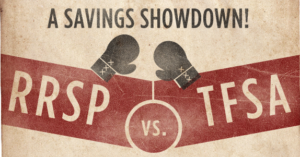
RRSPs are better for first-time homebuyers, while TFSAs are better for everyone else.
Congrats, you’ve made the wise decision of buying a home. Purchasing real estate offers many benefits – forced savings, a tax-sheltered long-term investment and the ability to turn your home into an income source by renting it out, to name a few. With almost 70 percent of Canadians choosing to own their homes instead of rent, many feel the same way.
While many Canadians aspire to own a home, the biggest hurdle is coming up with the down payment. In Canada, if you’re buying a home for $500,000 or less, you must come up with a minimum down payment of five percent of the purchase price (although that’s only the minimum – as I explain in my book, Burn Your Mortgage, it’s better to aim for a 20 percent down payment in more affordable markets like Saskatoon and Winnipeg and a 10 percent down payment in pricey markets like Toronto and Vancouver).
Let’s say you’re buying a $375,000 condo in Toronto. In that case, you’d have to come up with a down payment of $18,750 (five percent), although $37,500 (10 percent) is much better. Now I know what you’re thinking: that’s a lot of money to save, especially when you’re paying rent, a car loan and student debt (not to mention, it would be nice to have some money left over to have fun).
The good news is that the government sees homeownership is a wise investment, too. To encourage more Canadians to make the jump from renter to homeowner, you can use your Registered Retirement Savings Plan (RRSP) or Tax-Free Savings Plan (TFSA) to save towards your down payment sooner. Here’s an excerpt from my book, where I discuss the difference between the two.
RRSP Home Buyers’ Plan (HBP)
There’s no simpler, more powerful way to boost your down payment than with the Home Buyers’ Plan, or HBP. Under the HBP, first-time homebuyers can borrow up to $25,000 tax-free from their RRSP for a down payment. (If you’re buying with another first-time homebuyer, that’s a total of $50,000 you can borrow together.)
Don’t confuse the RRSP with investment vehicles like stocks and bonds. The RRSP is a tax-sheltered account that can hold a variety of investments, including savings accounts and GICs. You may contribute the lesser of 18 percent of your earned income from the previous year or the RRSP limit for the current tax year.
What makes the RRSP so powerful is that you’ll get a tax refund for your contributions. For example, if your tax rate is 30 percent, by contributing $10,000 to your RRSP, you’ll get a 30 percent tax refund (effectively $3,000)—that’s a 30 percent return on your money! (The size of your refund depends on your tax situation. You may get more or less back depending on your personal tax rate.)
If you decide to use the HBP, follow the rules to the letter. Don’t make the costly mistake of simply withdrawing the money from your RRSP without completing the required paperwork (you’ll face hefty withholding taxes and lose the RRSP contribution room). As Toronto Star columnist Ellen Roseman mentions in this article, make sure to complete form T1036 for each eligible RRSP withdrawal under the HBP (you’ll need to provide this to your lender). Your lender will send you a T4RSP, showing the amount of the HBP withdrawal in box 27.
Money borrowed under the HBP must be fully repaid within 15 years, with payments starting in the second year. If you fail to repay any amount, not only is it added back to your income as taxable (ouch!), but you lose the RRSP contribution room forever (double ouch!).
Some financial experts say that using the HBP isn’t a good idea because you’re borrowing money from your future self, and you’ll never get back the lost compound interest. That may be true, but in this crazy real estate market where home prices are rising a lot faster than wages, it’s hard to turn down a 30 percent risk-free return. The HBP makes sense for a couple of more reasons: (1) most Canadians have more RRSP contribution room than they know what to do with, and (2) you’ll save a boatload on your mortgage insurance premium if your mortgage is high ratio by making a larger down payment.
Tax-Free Savings Account (TFSA)
If you’re not a first-time homebuyer, the tax-free savings account (TFSA) is your best bet. Similar to the RRSP, the TFSA is a tax-sheltered account that can hold investments like GICs and saving accounts, making it perfect for long-term savings goals such as homeownership. Anyone who’s 18 or older can open and contribute to a TFSA.
Unlike the RRSP, you don’t get a tax refund from TFSA contributions, but similar to the RRSP, your money grows tax-free inside it. Where the TFSA has a leg up on the RRSP is that you don’t have to pay income tax when you withdraw your money. The TFSA was introduced way back in 2009, so you should have plenty of contribution room for saving toward your dream home.
Sean Cooper is the bestselling author of the book, Burn Your Mortgage: The Simple, Powerful Path to Financial Freedom for Canadians, available now on Amazon and at Chapters, Indigo and major bookstores, and as an Audiobook on Amazon, Audible and iTunes.